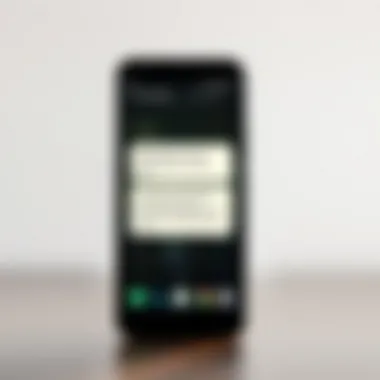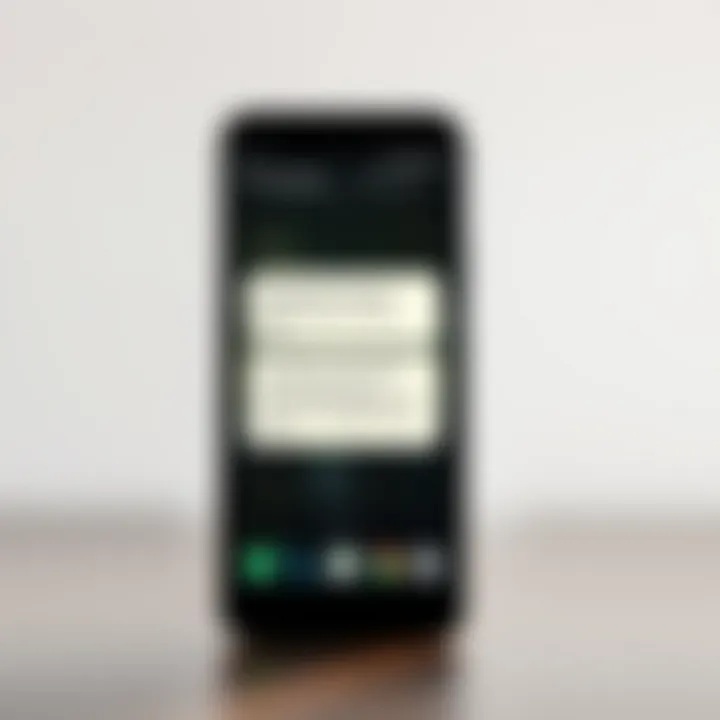Top Free Call and Text Apps for Android Without Wi-Fi


Intro
In today’s fast-paced digital world, staying connected is essential, but having access to Wi-Fi can often be a hindrance. Whether you're commuting, traveling, or simply enjoying a day out, you might not always find a reliable internet connection. This limitation can make communication challenging. Fortunately, there are numerous free call and text applications for Android that function without the need for Wi-Fi. This section will introduce these apps, highlighting their significance in modern communication.
Notably, these applications utilize mobile data, enabling users to make voice calls and send messages even when Wi-Fi isn’t available. The sheer versatility of today’s smartphones means that you can stay in touch with friends, family, or colleagues without being tethered to a router. Every app has its unique features, security protocols, and user interface, which can greatly affect how well they serve you in everyday life.
Understanding the available options can empower you to make informed decisions about which app suits your needs best. By navigating this landscape, you will not only enhance your communication experience but also ensure that you stay connected no matter where you are.
As we delve into the specifics of these applications, we'll cover essential features, examine performance and user experiences, and look at pricing structures. Whether you're an early adopter of technology or just someone who values convenience, there is something valuable in this exploration for everyone.
Preamble to Free Calling and Texting
In today’s fast-paced world, staying connected is more crucial than ever. The advent of smartphones has revolutionized how we communicate, allowing us to call and text with just a few taps. However, the cost associated with regular cellular services can be a significant drawback for many users. This is where free calling and text apps come into play. These applications provide alternatives that allow individuals to communicate without incurring hefty charges, even without a Wi-Fi connection.
Understanding Communication Channels
When discussing free call and text apps, it’s vital to grasp the different communication channels available. The world of digital communication has expanded beyond plain voice calls; it now includes texts, video calls, and even group chats. Through these apps, users can send messages or make calls over cellular data. This is particularly beneficial for users who may not always have reliable access to Wi-Fi.
- Cellular Data Usage: Many of these applications can function using mobile data, meaning that as long as a connection is available, users can stay in touch with friends, family, and colleagues.
- Variety of Options: There are numerous channels available through these apps, ranging from conventional text messaging to multimedia messaging, giving users diverse choices to communicate as they choose.
Importance of Connectivity
Being connected is not just about making a call or sending a text. It represents a lifeline for many individuals, particularly in emergencies or critical situations. While traditional phone services may be expensive, free call and text apps can bridge this gap for those who rely heavily on their mobile devices.
- Accessibility: The ability to communicate without being tied to Wi-Fi can open doors for individuals in rural areas or places with inconsistent internet service.
- Cost-Effective Solutions: For students, travelers, or anyone on a tight budget, these apps can provide essential services without the burden of additional expenditures. This cost-effectiveness is a game changer, particularly in areas where every penny counts.
"In a world where communication is key, these apps offer freedom and flexibility to connect without boundaries."
Overall, understanding the importance of free calling and texting apps not only helps in fostering relationships but also promotes a more connected society. As we evolve with technology, tapping into these resources could enhance our experience and ensure that we are always within reach.
Technology Behind Free Call and Text Apps
In the current landscape where instant communication reigns supreme, understanding the technology behind free call and text apps is key for maximizing their potential. These applications leverage both conventional telephony and modern web capabilities to provide users with diverse options for staying connected without relying heavily on Wi-Fi. This section explores the significant technologies that empower these apps, giving users insight into their functionality and effectiveness.
Voice over Internet Protocol (VoIP)
Voice over Internet Protocol, or VoIP, has transformed how we conduct voice communications. Unlike traditional telephony that uses circuit switching, VoIP converts voice signals into digital packets. This not only allows for a more efficient use of the available bandwidth, but it also opens up channels for free communication under certain conditions.
For instance, many users might not realize that VoIP can often work seamlessly over mobile data connections. This means that if you're out and about without Wi-Fi, your phone’s mobile data can still facilitate calls through various apps. Some popular applications that utilize VoIP technology include WhatsApp, Skype, and Viber. These platforms have successfully harnessed VoIP to deliver not only voice calls but also video calling features.
One of the primary benefits of VoIP is the cost-effectiveness it offers. Since data transmission over mobile networks can frequently surpass typical calling fees, users often find they can call even internationally without racking up charges. However, one thing to keep in mind is that call quality can fluctuate depending on several factors like network congestion and signal strength. It’s worth regularly checking your data usage on these apps to avoid unexpected charges, especially when using cellular data for calling.
SMS and MMS Functionality
When discussing communication, it can't be overlooked how SMS (Short Message Service) and MMS (Multimedia Messaging Service) play a pivotal role in texting dynamics. SMS allows for simple text messages to be sent and received, while MMS expands that capability to include media files like images, audio, and videos. In many free call and text applications, these functions are integrated to enhance user experience.
Most users have sent an SMS at some point, but this technology allows for more than just concise text. For example, apps like Signal and Telegram offer enhanced SMS and MMS functionalities that can include end-to-end encryption for texts, thus addressing privacy issues.
Using these apps, tapping into the power of SMS and MMS opens new avenues for creative messaging. Users can share experiences in real-time, whether it's a picture from last night's sunset or a quick audio message detailing their latest project. However, one must be cautious, as sending media-rich messages can incur higher data consumption when not connected to Wi-Fi.
To summarize, understanding VoIP and SMS/MMS is crucial for anyone serious about effective communication using free apps without a Wi-Fi connection. With this knowledge, users can leverage the available options to stay connected, balancing flexibility and data usage.
"Seamless communication is often the backbone of personal and professional relationships. When mobilized correctly, technology can bring us closer together, even without an internet connection."
By acknowledging these technologies, users can make informed choices on which apps to use, ensuring they remain connected on the go.
Key Features to Consider


When it comes to choosing a free call and text app for your Android device, there are several crucial features that can significantly influence your overall experience. With a multitude of apps flooding the market, understanding these key features allows you to navigate your options wisely, ensuring that you select an app that truly fits your communication needs without breaking the bank.
User Interface
The first impression of an app often comes from its user interface, or UI, as many call it. A well-designed UI is intuitive and straightforward, allowing users to navigate effortlessly. For instance, consider an app like Signal that boasts a minimalist design with large buttons and an easy-to-read font. A clean layout can reduce fumbling around for that elusive button to start a call or send a message.
Think about how frustrating it can be when features are buried under layers of menus. A great UI not only helps with ease of use but also minimizes the learning curve. For tech-savvy users who are always in a rush, the last thing you want is to waste time figuring out where the core functionalities are hiding. Look for designs that prioritize functionality while maintaining an aesthetic appeal.
Call Quality and Reliability
Next on the list is call quality and reliability—vital attributes in any communication app. When you’re in the middle of an important conversation, the last thing you need is a dropped call or poor audio quality. Apps like WhatsApp and Skype invest heavily in optimizing their call parameters, ensuring that users have a clear line, even when bandwidth is low.
Reliable service isn't just about clarity; it's also about consistency. You want an app that performs well across different conditions—whether you’re in a bustling city center or a quieter area with weaker signals. Reading user testimonials can provide insight into the real-world performance of an app. Look for indicators like minimal latency and commendable sound clarity, as these will enhance your communication experience more than you can imagine.
Messaging Options
Moving on to messaging options—this feature can vary greatly among apps, making it essential to assess what options are available beyond basic texting. Users often seek apps that incorporate not just SMS but also features like multimedia messaging, group chats, and even self-destructing messages for heightened privacy.
Applications such as Telegram stand out for their robust messaging capabilities, allowing users to share not only text but also photos, videos, and files seamlessly. If you communicate widely with different media, consider what each app can support. Group messaging is also a critical feature for both business and personal communication, enabling chat among multiple users simultaneously.
In summary, before settling on a free call and text app, consider the user interface, call quality, and messaging options. These elements form the bedrock of an effective communication tool. Solidifying your understanding of what these features entail helps in making an informed decision—and in the world of apps, that’s half the battle.
Popular Apps for Android Users
In the ever-expanding world of communication technology, free call and text apps have carved a niche for themselves among Android users. The significance of these apps cannot be overstated, especially as the demand for connectivity without reliance on Wi-Fi continues to rise. With a myriad of options available, identifying the right apps can greatly enhance one’s communication experience.
Unlike traditional cellular networks, these applications allow users to make calls and send messages using mobile data. This is particularly beneficial for individuals who may not have consistent access to Wi-Fi but possess limited data plans. The implications are vast; not only do these apps offer versatility and convenience, but they also enable users to stay connected regardless of their surroundings.
Here’s a closer look at a few leading applications that have gained popularity for their robust functionalities and global reach.
Overview of Leading Applications
When browsing the ocean of free call and text apps for Android, several standout options emerge, each catering to different needs and preferences. Some notable apps include:
- WhatsApp: This widely used app provides services for free messaging, voice, and even video calls. Its user-friendly interface and end-to-end encryption make it a favorite.
- Signal: Known for its strong privacy measures, Signal offers encrypted calls and texts. It’s gaining traction among privacy-conscious users.
- Telegram: This app supports not just texting and calling but also large group chats, making it a preferred choice for creating communities.
- Viber: With its international calling features, Viber enables users to connect with contacts worldwide, plus its stickers and multimedia options add flair.
Each of these applications has developed unique features that enhance user experience, from multimedia sharing to group chats, ensuring that there's something for everyone.
Comparative Analysis of Features
Diving deeper into the specifics, a side-by-side comparison of some features offered by these apps provides valuable insight for potential users.
Call Quality
One key aspect to evaluate is call quality. While WhatsApp and Signal are known for their reliability, users might experience hiccups on less stable networks. Viber, on the other hand, tends to excel in international calling, often providing clearer lines and reduced latency.
Privacy and Security
Regarding privacy, Signal stands out for its commitment to user data protection, utilizing advanced encryption algorithms. WhatsApp, although it has restrictive data policies, still ensures a decent level of security through its design.
Group Features
Telegram offers the most in terms of group functionalities, allowing up to 200,000 members in a single group chat. This feature can be indispensable for team communication or community-building efforts.
In essence, while many of these apps overlap in terms of basic functionalities, the choice ultimately comes down to specific needs such as privacy, call quality, and group engagement.
"Choosing the right app can make a world of difference in how effectively you communicate in your daily life."


In summary, these popular applications are not just tools for communication; they represent a shift in how we connect, share, and interact in an increasingly digital world.
Evaluating Security and Privacy Concerns
In today’s world, where communication happens faster than a cat on a hot tin roof, evaluating security and privacy concerns is essential when using free call and text apps. With the surge in digital communication, understanding the potential vulnerabilities of these applications is not just a prudent move; it’s a necessity. Users must be aware that their personal and sensitive information might be at risk when utilizing these platforms. Focusing on security and privacy means examining how these apps handle data and what measures are in place to protect users.
Given the broad array of free messaging and calling options available, one can’t simply pick and choose without considering the implications of that choice. A thorough understanding of how apps manage user data can enhance the overall communication experience while safeguarding personal information.
Data Encryption Practices
When it comes to protecting your messages and calls, data encryption is like a vault for your valuable information. It’s a technique that encodes your data so that only intended recipients can access it. Most reputable free call and text apps employ some form of encryption, but not all are created equal.
Here are some key points to consider regarding data encryption:
- End-to-End Encryption: This ensures that only the sender and the recipient have access to the messages. Even the service provider can’t read them, providing a robust layer of security.
- Transport Layer Security (TLS): This is crucial for protecting data in transit. It helps ensure that the data traveling between your device and the server remains confidential.
- Regular Updates: Applications that frequently update their security protocols tend to stay ahead of potential vulnerabilities. It's essential to choose apps that have a proactive approach to security.
By examining the encryption practices of any free call or text app, you can make a more informed choice about your communication tools.
User Privacy Policies
User privacy policies might seem dull, but they’re pivotal in understanding how your information is being used—or misused. A clear and concise privacy policy should outline what data is collected, how it’s used, and whether it’s shared with third parties. Here’s what to look for:
- Transparency: A good privacy policy will clearly state what data is collected from you and how that data is managed. If it’s vague or overly complicated, that’s a red flag.
- User Consent: Recognize whether the app seeks your explicit consent for data collection. This includes opting into sharing personal information, and the option to opt-out should be readily available.
- Data Retention: Understand how long your data is stored. Some apps might keep records indefinitely, which can pose a security risk.
- Updates and Revisions: Privacy policies can change frequently. If an app updates its policy, users should be informed and have the opportunity to review changes.
By staying informed about the privacy policies of free call and text apps, users can protect themselves and their data in an interconnected landscape.
"In an age of information, a little knowledge about security can save you a world of trouble." - Anonymous
User Experience and Feedback
In the realm of communication apps, user experience stands as a critical pillar influencing choices and satisfaction. When it comes to free call and text applications for Android that operate without Wi-Fi, feedback from users provides a goldmine of insights that highlight the practicalities and pitfalls of these tools. Engaging with user reviews allows prospective users to gauge the effectiveness, reliability, and overall enjoyment of using different apps.
Moreover, positive user experiences can spark a sense of community among app users, creating a shared enthusiasm that drives further usage. Conversely, negative feedback often highlights potential issues that could deter new users. Understanding these dynamics can help someone make an informed decision tailored to their needs.
Current User Reviews
User reviews vary widely, reflecting unique experiences and preferences, making them a rich resource for understanding the efficacy of these apps. Many individuals express satisfaction with user-friendly interfaces that streamline the calling and messaging process. For instance, apps like Google Voice and TextNow often receive accolades for their easy navigation and well-designed dashboards. Users appreciate when they can jump right into the action without the need for lengthy tutorials or troubleshooting.
On the flip side, reviews detail frustrations with connectivity issues, specifically when dependent on cellular data. Instances where users struggle with dropped calls or lagging texts can prompt red flags for those relying on these apps for important conversations. Some user comments underline dissatisfaction with limited customer service options, which can lead to feelings of abandonment in times of need.
"I've used TextFree for months, and while the interface is sleek, I sometimes find calls dropping, especially in low-signal areas. It’s a bit frustrating, but text messaging is rock solid!"
— A user review from Reddit.
Common Issues and Solutions
Despite the advantages, users often encounter common issues when using free call and text apps without Wi-Fi. Recognizing these challenges can guide users toward practical solutions that enhance their experience.
- Connectivity Problems: Many users find that the app performance fluctuates based on their mobile signal strength. If experiencing issues, switching to a location with better coverage can drastically improve call quality.
- Battery Drain: Heavy usage of communication apps can lead to rapid battery depletion.
- Limited Features in Free Versions: Some apps, while functional, place restrictions on features unless users subscribe to a premium version.
- Privacy Concerns: Many users worry about data tracking by these apps, leading to hesitance in personal information sharing.
- Solution: Adjust the app's background usage settings or close unused apps to conserve power.
- Solution: Before downloading, check app descriptions and online forums to get an idea of which paid features are worth the investment.
- Solution: Research privacy policies beforehand to ensure that the app aligns with your comfort level.
In the fast-paced world of communication technology, user experience and feedback play a vital role. Making informed choices based on real user accounts can enhance overall satisfaction with free call and text apps, ensuring users choose options that best fit their needs.
Limitations of Free Call and Text Apps


When it comes to the world of free call and text apps for Android, it’s essential to have a clear-eyed view of their limitations. While these apps offer a golden opportunity to communicate without a hefty bill, they come with certain caveats that anyone looking to rely on them should be aware of. Understanding these limitations can help users make informed decisions, maximizing the benefits while minimizing potential frustrations.
Dependence on Cellular Data
One of the most glaring limitations is the dependency on cellular data. While Wi-Fi-free communication sounds appealing, users are often left tethered to their mobile data plans. If you find yourself in a low-signal area, the quality of your calls may suffer significantly. Call drops or poor audio quality become common occurrences, and your messages might not go through or could be significantly delayed.
"Having a backup plan is key. You can find yourself out of service quicker than you think", a seasoned user once advised.
On top of that, heavy usage can lead to hitting your data cap quicker than anticipated. For instance, a simple thirty-minute call on a VoIP service could chew through a chunk of your monthly data limits, leaving you facing throttled speeds or overage charges. Hence, while these apps promote cost-effectiveness, they can become expensive if you don’t keep an eye on data usage.
Subscription Models and Hidden Costs
Certain freemium models offer enticing features but have hidden costs that can catch unsuspecting users off guard. Users may initially think they're saving a pretty penny by avoiding traditional mobile carriers, but allure of extra features can lead to additional payments. Subscription models can include features such as ad-free experiences, higher call quality, or premium messaging options.
It's fundamental to read the fine print and consider what you might need long-term. Features like more storage for message history or exclusive stickers can come with a price tag, undermining the initial appeal of "free" services. Plus, some apps may offer limited functionalities for free, pushing users toward a paid subscription just to unlock basic features.
Future Trends in Communication Apps
As we sink deeper into the information age, the landscape of communication apps is continually shifting. For those who rely on free call and text solutions, understanding future trends is not just beneficial; it’s essential for staying relevant in a fast-paced digital world. By keeping an eye on these trends, users can better anticipate their communication needs, ensuring they choose the right tools and platforms.
Technologies evolve rapidly, and the integration of various digital innovations can reshape our daily interactions. Communication applications are highly influenced by these technologies, which means users can expect enhanced features, better user experience, and, importantly, increased security. These aspects are not just technical jargon; they translate into real-world benefits for those using free services to connect with friends, family, or colleagues.
Integration of AI and Machine Learning
Artificial Intelligence and Machine Learning are guiding a new chapter in the world of communication apps. Imagine an app that not only understands your preferences but can also suggest the best times to reach out to your contacts based on their availability. Such applications utilize machine learning algorithms that analyze usage patterns, making the communication process more fluid and intuitive.
Moreover, the integration of AI helps enhance security. Features like fraud detection, spam filtering, and even predictive text come in handy to make communications smoother. Users won’t have to worry about dodgy messages or unwanted intrusions as these systems continually learn and adapt to the user's patterns, making security more robust over time.
For example, a messaging app could potentially predict when you’re most likely to respond, enabling seamless interaction between parties. The AI-detected legislation around the type of data utilized also means that apps can operate under stricter privacy constraints, which is increasingly significant in today’s climate of data breaches. The potential here is enormous, and those who stay on top of these emerging AI features will solidify their advantage in communication.
Emerging Technologies Impacting Communication
The realm of communication apps is witnessing an explosion of innovative technologies. One such innovation is 5G technology, which brings faster data speeds and lower latency. This means clearer calls and instantaneous message deliveries, even in crowded places. As more people come on board with 5G, it opens the door for more robust and feature-rich calling and texting applications.
Another noteworthy trend is the rise of blockchain technology in ensuring secure communication. This technology is gradually becoming recognized for its unique approach to security. By decentralizing data storage, it mitigates risks associated with hacks or breaches commonly faced by conventional apps. A decentralized framework could lead to new apps that work without traditional servers, enhancing accessibility and security at the same time.
Additionally, augmented reality (AR) and virtual reality (VR) technologies are on the brink of changing the way we communicate. Imagine being able to have a video call through a virtual environment where you interact as if you were in the same room. It seems like science fiction, but the groundwork is already laid, making it a potential reality very soon. By tapping into these technologies, developers can create experiences that make remote conversations feel much more intimate and personal.
"Staying ahead of these trends isn't just wise; it's becoming necessary. As tech-savvy individuals, adapting to these changes can profoundly enhance how we interact and communicate."
As these emerging trends unfold, they paint a picture of an exciting and dynamic future for communication applications. Being aware of these developments equips users with the knowledge they need to adapt and thrive in their personal and professional lives.
The End and Recommendations
In wrapping up our exploration of free call and text apps for Android that operate without a Wi-Fi connection, it's essential to synthesize the key insights gleaned in the process. The sheer prevalence of these applications speaks volumes about our modern communication needs. As users, it’s imperative to comprehend not only the functionalities that these tools offer but also their limitations and potential risks.
Summary of Insights
When navigatin this rapidly evolving domain, several insights stand out. Firstly, the rise of VoIP technology has changed the communication landscape fundamentally. Today, many apps utilize your cellular data to provide free or low-cost calling and messaging services. However, while these apps can be a godsend when Wi-Fi isn’t available, they often rely on a stable mobile data connection. Therefore, it’s vital to assess your data plan to avoid unexpected charges.
Moreover, security remains a top concern as these applications store personal information and communication histories. Users must take the time to review privacy policies and understand the encryption practices surrounding their chosen apps. Familiarizing oneself with user reviews further enhances the decision-making process, shedding light on common issues and the solutions provided by developers.
In essence, if you’re considering making the switch or trying a new application, factor in your specific needs and preferences. What works well for one user might not suit another. Make sure to weigh the pros and cons carefully before diving in.
Practical Tips for Users
When using free calling and texting apps, here are some practical tips to enhance your experience:
- Choose Wisely: Conduct thorough research on available apps. Look for options like WhatsApp, Viber, or Signal, which might suit your communication habits well.
- Check Compatibility: Verify that your Android version supports the app you choose to avoid functionality hitches.
- Read Privacy Policies: Familiarize yourself with how the app manages your data and ensure it aligns with your privacy preferences.
- Monitor Data Usage: Keep a close eye on your data consumption, especially when using these services frequently. Most smartphones have built-in tools to track this.
- Engage with Reviews: Before downloading, read current user feedback to anticipate possible challenges or discover useful features.
- Stay Updated: Regularly update the apps to benefit from the latest features and security enhancements.
By adhering to these suggestions, you can make the most of free calling and texting apps while minimizing potential drawbacks. Understanding the implications of your choices is key in this digital age, ensuring seamless communication even beyond the bounds of Wi-Fi.
“Knowledge isn't just power; it's the key to staying connected in a disconnected world.”



